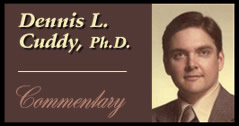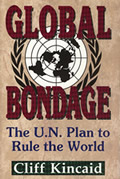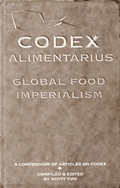THE MANAGEMENT PLAN
PART 1
By
Dennis L. Cuddy, Ph.D.
August 11, 2008
NewsWithViews.com
[Note: Regarding how things are “managed,” this applies even to sports. I was watching a PGA golf tournament with a lot of highly paid and praised golfers. But during the event, TV ads were shown promoting new golf clubs that would make golf balls go straighter, and new golf balls that would go farther or even be engineered to help individual golfers’ needs! Can you imagine the outcry in baseball, for example, if the pitcher used a baseball manufactured to curve more sharply? Sports are supposed to judge the abilities of the athletes themselves over the years, not the ability of technology to “manage” improved results. If athletes wore shoes with more “spring” in them, I’m sure they could run faster and jump farther and higher. But so what!? Concerning golf, I’d like to see today’s so-called “greats” use the same ball and clubs Bobby Jones used 75 years ago. They probably couldn’t be consistently under par!]
Today there are management plans and management consultants everywhere, and people are no longer called “personnel” but rather “human resources” who are to be “managed.” From where did this idea come?
In the mid-1700s, the Encyclopedists or Enlightenment philosophers like Diderot, Montesquiue and others, were in the ascendancy. One of the most prominent was Jean Jacques Rousseau whose SOCIAL CONTRACT served as a basis for the French Revolution, which called for philosopher-kings (as in Plato’s REPUBLIC) to rule over the masses, to manage them “for their own good.”
Dispersed members of the Illuminati (Enlightened Ones), played an important part in the French Revolution as members of the Parisian Outlaws League, rebelling against all authority, monarchical and religious. The Marquis de Lafayette played a prominent role in overthrowing royal rule in France, and in the early 1800s he brought to the U.S. Madame Francoise d’Arusmont (Fanny Wright), who joined with Robert Dale Owen to form the first commune in America in New Harmony, Indiana in 1825. Owen was the son of Robert Owen who, with Jeremy Bentham and others, supported the concept of utilitarian communes in England.
The Owens came to the U.S., according to Robert Owen, “To introduce an entire new order of society; to change it… to an enlightened social system, which shall gradually unite all interests into one and remove all cause for contest between individuals.” Robert Dale Owen and Fanny Wright joined with Orestes Brownson to found The Working-Men’s Party in 1829 toward that end. According to Brownson, they also planned “to establish a system of national schools from which all religion was to be excluded…. Our complete plan was to take the children from their parents at the age of 12 or 18 months, and to have them nursed, fed, clothed, and trained in these schools at the public expense…. The plan has been successfully pursued.”
While they were planning these activities in the U.S., in France in the early 1800s a “philosopher-king” St. Simon was proposing a universal association of all men in an industrial feudalism with workers under the control/management of a self-appointed elite. Ludwig von Westphalen taught these principles to his son-in-law, Karl Marx, who was paid by the League of the Just (an outgrowth of the Parisian Outlaws League) to write THE COMMUNIST MANIFESTO. The philosopher-kings wanted Marxist Communism ultimately as a dialectical antithesis to Capitalism (thesis), synthesized into a World Socialist Government (Pierre Leroux actually coined the word “Socialism”).
The Socialist Society planned by St. Simon would be “scientific” in nature. And the “science” would be called “sociology,” a term coined by St. Simon’s secretary, Auguste Comte around 1838. In 1901, the “Father of American Sociology,” Edward Alsworth Ross, in his book SOCIAL CONTROL would reveal that social checks and stimuli “are managed by a rather small knot of persons… the Elite…. Judgment may be moulded as well as the will and the feelings.” In society, people’s work functions, values, etc., were to be “managed” by an elite in a new “Religion of Humanity” that would unite all religions in service to “Humanity.”
Comte explained this system in a 6-volume set titled POSITIVE PHILOSOPHY between 1830-1842. And on October 19, 1851 he closed a series of lectures titled “The History of Humanity” with the following statement: “In the name of the Past and the Future, the servants of Humanity – theoreticians and practitions – come forward to claim as their due the general direction of this world, in order to construct at length the true Providence, moral, intellectual, and material; excluding once for all from political supremacy all the different servants of God – Catholics, Protestants, or Deists – as at once belated and a source of trouble.” Comte developed his Positive Philosophy into a SYSTEM OF POSITIVE POLITY, the title of a 4-volume set by Comte from 1851-1857. In this system, collective Humanity became more important than the individual, and it replaced God as the focus of worship.
In this managed materialistic system, feelings became more important than intellect because feelings are more easily manipulated/managed. It was planned that this would be the basis upon which education would occur beginning in the last half of the 19th century.
Since this was a new polity, it was to be expected that the youth of that time would carry this philosophy with them into higher education and law school. This was the case with youths as Felix Frankfurter and Oliver Wendell Holmes, who in the first decades of the 20th century carried it with them into our courts and ultimately as Justices of the U.S. Supreme Court.
They were known as “Positivists” and legally ruled (on the basis of Comte’s system) that the Constitution could mean whatever they chose it to mean for the good of the people/Humanity. For example, Holmes in Buck v. Bell (May 2, 1927) ruled that for the good of society/Humanity, individuals with low intelligence (“imbeciles”) could be forcibly sterilized. After Holmes wrote to his Fabian Socialist friend Harold Laski about this case, Laski replied, “Sterilize all the unfit, among whom I include all fundamentalists.”
Comte’s system was also promoted by W. T. Stead, Cecil Rhodes’ and occultist Annie Besant’s close friend. Stead helped Rhodes develop his secret society’s plan to “take the government of the whole world,” and he helped Besant to pursue her Theosophical goals. Besant was succeeded by Alice Bailey, who in 1925 founded The New Group of World Servers (www.ngws.org) to help solve the PROBLEMS OF HUMANITY, the title of her 1947 book.
They would engage in service to Humanity, as Comte directed. And for Stead’s part, he delivered an address to the 1893 World Parliament of Religions on its 15th day, stating: “…The work of the Civic Church is to establish the kingdom of heaven here among men – in other words, to reconstitute human society…. The Civic Church embraces in its comprehensive synthesis all the religions, from the fetish worshiper to the Christian philanthropist…. The objective of the Civic Church includes… the greatest possible good for the greatest possible number…. All must meet on the common ground of the service of man…. Workers must be found who can look at the community as a whole. They must endeavor by hook or by crook to get into existence some federation of the moral and religious forces which could be recognized by the community as having authority to speak in the name and with the experience of the Civic Church….” Stead also hoped that “an ideal selective Humanitarian Episcopate on democratic lines can be evolved.” And he concluded his address by stating that “all the forces of civilization and religion will work for the establishment of the Civic Church.” [THE WORLD’S PARLIAMENT OF RELIGIONS, Vol. 2 (Chicago: Parliament Publishing Co., 1893), pp. 1209-1215].
Shortly after Bailey founded The New Group of World Servers, the Fabian Socialists in Britain instituted Political and Economic Planning (PEP). PEP member Israel Moses Sieff said, “Let us go slowly for a while, until we can see how our plan works out in America.” He was referring to FDR’s New Deal, which was drafted by the National Planning Association (NPA).
|
Subscribe to the NewsWithViews Daily News Alerts! |
Both PEP and NPA (like the Rockefeller Foundation, the National Education Association, etc.) were concerned with the social control/management of people. Franklin Roosevelt was elected president in 1932, and one of his New Deal programs was the Resettlement Administration (RA). In the late 1930s, the RA put into practice the Sociometric principles of Romanian psychiatrist J. L. Moreno in its Centerville Project. Moreno (author of WHO SHALL SURVIVE? in 1934) was told by FDR in Hyde Park one day that “when I am back in Washington, I will see where your ideas can be put to use.” And in the RA’s Centerville Project, families were selected and located based on certain characteristics, such as whether they were religious. Interrelations were examined after six months, and a reassignment of houses occurred because in Moreno’s population management plan, “sociometric principles dictated (certain) sacrifices for the benefit of the whole structure” (SOCIOMETRY, July-October 1937). For part two click below.
Click here for part -----> 2,
� 2008 Dennis Cuddy - All Rights Reserved

















